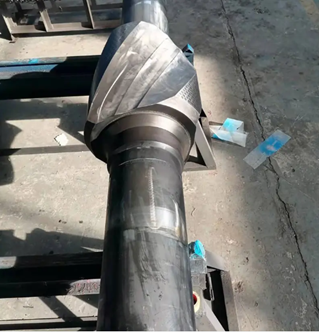The sleeve stabilizer is a device installed on the casing string to center the casing string in the wellbore. It has the characteristics of simple structure, convenient use, long service life, and low cost. The main function of the sleeve stabilizer is:
l Reduce casing eccentricity, improve cementing displacement efficiency, effectively prevent cement slurry from channeling, ensure cementing quality, and achieve good sealing effect.
l The support of the sleeve stabilizer on the casing reduces the contact area between the casing and the wellbore wall, thereby reducing the frictional force between the casing and the wellbore wall, which is beneficial for the casing to be moved when running into the well and cementing.
l Reduce the risk of casing sticking in the lower casing and lower the risk of casing sticking. The sleeve stabilizer centers the casing and prevents it from sticking tightly to the wellbore wall. Even in well sections with good permeability, the casing is less likely to be stuck by mud cakes formed by pressure differentials and cause drilling jams.
l The sleeve stabilizer can reduce the bending degree of the casing in the well, thereby reducing the wear of the casing by the drilling tool or other downhole tools during the drilling process after the casing is installed, and playing a role in protecting the casing.
There are various types of sleeve stabilizers, and their selection and placement are often based on experience during on-site use, lacking systematic theoretical summary and research. With the increasing development of drilling towards complex wells such as ultra deep wells, large displacement wells, and horizontal wells, conventional sleeve stabilizers are no longer able to meet the needs of underground construction. Therefore, it is necessary to conduct a systematic analysis and comparison of the structural characteristics, applicability, and optimal placement of different types of sleeve stabilizers to guide on-site construction operations.
Classification and characteristics of casing centralizers
According to the actual well conditions and the structural characteristics, manufacturing processes, and materials of sleeve stabilizers, sleeve stabilizers are divided into different types. According to the standards of the petroleum industry, sleeve stabilizers are usually divided into elastic stabilizers and rigid stabilizers.
1.1 Classification and technical characteristics of elastic stabilizers
Elastic centralizer is the earliest and most widely used type of centralizer. It has low manufacturing cost, diverse types, and the characteristics of large deformation and recovery force. It not only ensures the centering of the casing, but also has good passability for well sections with large diameter changes, reduces the frictional resistance of casing insertion, and improves the uniformity of cement consolidation between the casing and the wellbore.
1.2 Classification and technical characteristics of rigid stabilizers
Unlike elastic stabilizers, rigid stabilizers themselves do not undergo any elastic deformation, and their outer diameter is designed to be smaller than the size of the drill bit, resulting in lower insertion friction, making them suitable for use in more regular wellbore and casing.
Optimal selection of combination method for 3 casing centralizers and placement
Different sleeve stabilizers have their own advantages and disadvantages due to differences in structure, material, and manufacturing process, and are suitable for different well conditions. The same type of casing centralizer, due to different placement methods and spacing, can also result in different centralizing effects and casing friction. For example, if the centralizer is placed too tightly, it will increase the stiffness of the casing string, making it difficult to insert the casing and increasing operating costs; Insufficient placement of stabilizers can result in excessive contact between the casing and the wellbore, leading to poor centering of the casing and affecting the quality of cementing. Therefore, according to different well types and conditions, selecting the appropriate sleeve stabilizer and placement combination is crucial for reducing casing friction and improving casing centering.
Post time: Aug-06-2024





